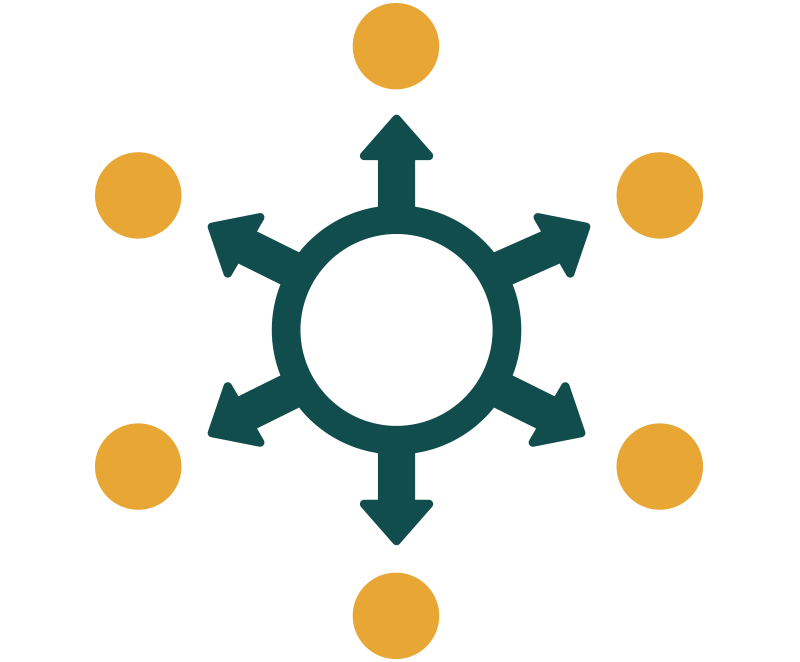Explore Market Pressures and Transformative Shifts
Learning Objectives
After completing this unit, you’ll be able to:
- Define the four Ds of energy transformation.
- Explain the factors driving digital transformation for energy and utility companies.
- Describe the impact of distributed energy resources and demand-side management on the energy market.
The Four Ds of Energy Transformation
Transformative shifts are taking place in the energy and utilities industries, including deregulation, decentralization, and distributed energy resources (DER). Moreover, decarbonization, digitalization, and demand-side management are intensifying the shift. Energy transformation is defined by four Ds: decarbonization, deregulation, digitalization, and decentralization. Here’s a closer look at each of these processes.
Decarbonization
Decarbonization is the move to cleaner energy and conservation behavior. This move changes the technologies used to generate power, such as wind and solar.

In turn, the changes impact the infrastructure of the business as well as the products available to customers. Types of products resulting from decarbonization include green energy and renewable-based products. As a result, these changes affect customer-facing sales and service opportunities.
Deregulation
Deregulated markets are moving away from verticalized utilities. Thanks to this shift, new market models are emerging in which nontraditional energy companies can now own the energy-customer relationship.

Because of this, traditional utility companies need new products and systems to support existing products and compete successfully. This means increased demands on their systems.
Digitalization
Digitalization includes using the cloud, Internet of Things (IoT), and big data to build smarter, more responsive grids, with an additional focus on customer behavior.

Customers are now used to the sophisticated digital services offered in other industries and expect the same from their utility companies. Learn more about digital transformation later in this unit.
Decentralization
With more onsite customer generation and distributed energy resources, such as solar power, EVs, microgrids, and battery storage, customers have more choice and power over the grid than ever.

While this seems positive for customers, it places a new and increased burden on keeping a utility’s infrastructure safe, as the utility no longer owns, maintains, or physically controls all the energy resources that are now part of its energy grid.
What’s Driving Digital Transformation?
As the energy industry evolves, customer expectations and utility innovations become increasingly varied. Take a look at some of the questions utilities ask as they try to meet the demands of the new-age energy industry.
Customer Expectations and Value
How do you keep up as a utility company? How do I personalize my products and communications for my vastly diverse customer base? How do I meet the customers where they want to be and anticipate their needs? How do I provide true value to my customers?
Digital-First, Work-from-Anywhere, Real-Time
How do I deliver a digital-first experience for my customers and employees, connecting them from anywhere? Can I be agile enough? Can I generate insights and enable actions in real time that are valuable to my customers and that support our business objectives?
Disruptive Regulatory and Technology Change
What'll the industry landscape look like in a competitive market, with new distributed, democratized, and decarbonized energy programs? How do I use IoT, smart devices, meters, and VPPs or networks to make the most of grid, customer, and business value? What’s my place in new energy market models?
Salesforce solutions support all types of utility market models across the globe and are flexible enough to meet the different expectations and innovations of each market.
Impact of Distributed Energy Resources
DERs are electrical generation and storage facilities that consist of a variety of small, grid-connected, or distribution-system-connected devices. Distributed generation and storage enable the collection of energy from many sources, lower environmental impacts, and improve the security of supply.

Conventional power stations, such as coal-fired and gas stations, nuclear-powered plants, hydroelectric dams, and large-scale solar power stations, are centralized and often transmit electric energy over long distances.
In contrast to conventional power stations, DER systems are decentralized, modular, and use flexible technologies that are located close to the load they serve. However, DERs have capacities of only 10 megawatts (MW) or less. Multiple generation and storage components can form these systems, which are sometimes called hybrid power systems.
DER systems typically use renewable energy sources, such as hydro, biomass, biogas, sun, wind, and geothermal. DERs play an important role in the electric power distribution system as the energy industry moves toward renewable energy.
Grid-Connected Devices
A grid-connected device for electricity storage can also be classified as a DER system and is called a distributed energy storage system (DESS). DER systems can be managed and coordinated in a smart grid through an interface.
Microgrids
Microgrids are modern, localized, small-scale grids, as opposed to the traditional, centralized electricity grid or macrogrid. DERs can be the components of a microgrid. Think of a microgrid as a small, standalone grid, capable of meeting the energy needs of a defined area, such as a community or an area of several city blocks. To be self-sufficient in the provision of energy, a microgrid needs one or more sources of energy.
In the past, microgrids used diesel generators. Now, they often include DERs like solar or wind. On a larger scale, microgrids also add efficient batteries to the mix to store energy.
Microgrids can disconnect from the centralized grid and operate autonomously, strengthen grid resilience, and help mitigate grid disturbances. They’re typically low-voltage AC grids that use diesel generators and are installed by the communities they serve. Microgrids nowadays employ a mixture of different DERs, such as solar hybrid power systems, which significantly reduce carbon emissions.
Impact of Demand-Side Management
Demand-side management (DSM) is a group of actions designed to efficiently manage a site’s energy consumption to cut the costs incurred for the supply of electrical energy. Costs arise from grid charges and general system charges, including taxes.
One way utilities can meet demand on the grid is to reduce demand from the customer side by influencing customer consumption. The energy you save is measured in negawatts. No, it's not a joke. A negawatt is a hypothetical unit of power for measuring the amount of energy saved due to efficient energy consumption. A negawatt is the cheapest electron because it’s the one you don't use.
Utilities use conservation or energy-efficiency programs to help customers commit to using little or no energy during certain peak times, which allows the utility company to keep reserve power plants shut down. Without these programs, utilities often fire up reserve plants to meet customer demand. For instance, when all of the air conditioners switch on at the same time during a Los Angeles heat wave.
DSM optimization aims to achieve savings in electricity charges by modifying features of electricity consumption related to the:
- Overall consumption picture
- Consumption time profile
- Contractual supply parameters, including contractual power and grid connection parameters
As a result of the high penetration of renewable sources and the decentralization of production sources, grid managers in many countries now see increased instability on the grid and consequent disruptions to services.
Grid Services
Grid managers can use generation and consumption systems that offer grid services to limit the impact of service disruptions and ensure a balance between energy consumption and the amount of power fed into the grid. To engage in demand-side management, the first requirement is to carry out an in-depth analysis of onsite consumption. This involves assessing the unique requirements of each site and whether utilities can improve the consumption habits of customers.
Whenever a change in habit is unfeasible or simply insufficient to achieve the desired cost reductions, utilities can evaluate these onsite installation elements.
- Battery energy storage systems (BESS)
- Renewable-source systems, such as solar panels and wind turbines
- Cogeneration systems
Summary
Great job! You learned about the energy industry, utility services, and the companies providing them. You gained an overview of the various energy markets and their impact on utility companies. You also learned about the energy and utilities industry terms, units of measure, and pricing methods. And finally, you explored the challenges the energy and utilities industry is facing and how the industry is transforming in the evolving business environment.
Want to Learn More?
The Energy and Utilities Cloud Basics badge is a great place to start. Then, if you’re a consultant or developer, check out the following learning journeys to find out how to skill up on our amazing suite of digital transformation tools and industry applications.